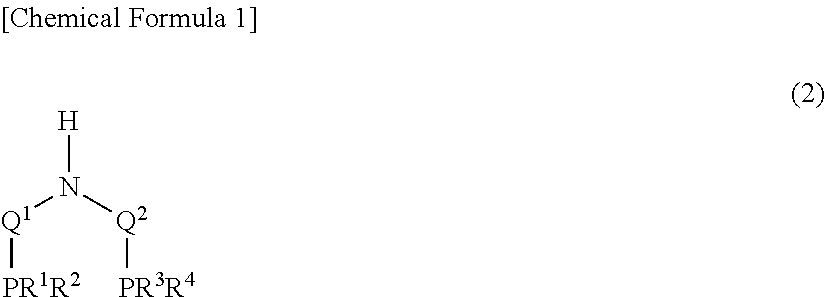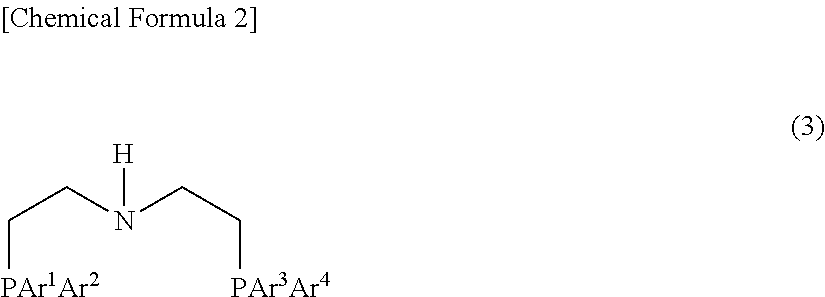Method for alkylation of amines
a technology of catalytically alkylating amines and amines, which is applied in the preparation of amino compounds, organic compounds/hydrides/coordination complexes, physical/chemical process catalysts, etc., can solve the problems of cost and industrialization like, and achieve the effects of high stability, easy preparation, and convenient handling
- Summary
- Abstract
- Description
- Claims
- Application Information
AI Technical Summary
Benefits of technology
Problems solved by technology
Method used
Image
Examples
reference example 1
Production of Ruthenium Carbonyl Complex 1
[0154]1.4 g of ruthenium carbonyl complex 1 was produced according to the method described in WO 2011 / 048727 A1.
reference example 2
Production of Ruthenium Carbonyl Complex 2
[0155]Ruthenium carbonyl complex 2 was produced according to the method described in WO 2011 / 048727 A1, wherein the reaction was carried out according to the following reaction formula.
[0156]Under a nitrogen atmosphere, 329 mg (1.07 mmol) of ligand (b) and 922 mg (0.956 mmol) of ruthenium complex (a) as a raw material were added to a 20 ml Schlenk tube, 3 ml of diglyme was added, and the mixture was heated at 165° C. for 1 hour. The reaction mixture was cooled to −15° C., the precipitated crystals were separated by filtration, and the crystals were washed with diethyl ether. The obtained crystals were dried in vacuo, whereby 180 mg (0.39 mmol) of ruthenium carbonyl complex 2 was obtained.
[0157]1H-NMR (300 MHz CD2Cl2): δ=−16.30 (t, J=18.0 Hz, 1H), 1.01-1.49 (m, 24H), 1.72-1.84 (m, 4H), 2.20-2.36 (m, 4H), 2.62-2.70 (m, 2H), 3.15-3.33 (m, 2H), 3.42 (bs, 1H)
[0158]31P-NMR (121.5 MHz CD2Cl2): δ=75.1 (s)
[0159]HRMS(ESI): m / z
[0160]As C17H38NOP2ClRu, ...
reference example 3
Production of Ruthenium Carbonyl Complex 3
[0162]Ruthenium carbonyl complex 3 was produced according to the method described in WO 2011 / 048727 A1, wherein the reaction was carried out according to the following reaction formula.
[0163]Under a nitrogen atmosphere, 706 mg (1.52 mmol) of ligand (c) and 1320 mg (1.37 mmol) of ruthenium complex (a) as a raw material were added to a 20 ml Schlenk tube, 4.3 ml of diglyme was added, and the mixture was heated at 165° C. for 1 hour. The reaction mixture was cooled to 0° C., the precipitated crystals were separated by filtration, and the crystals were washed with diethyl ether. The obtained crystals were dried in vacuo, whereby 581 mg (0.92 mmol) of ruthenium carbonyl complex 3 was obtained.
[0164]1H-NMR (300 MHz CD2Cl2): δ=−16.37 (t, J=18.0 Hz, 1H), 1.25-2.02 (m, 50H), 2.20-2.40 (m, 8H), 3.19-3.25 (m, 2H), 3.50-3.52 (m, 2H)
[0165]31P-NMR (121.5 MHz CD2Cl2): δ=52.8 (d, J=14 Hz)
[0166]HRMS(ESI): m / z
[0167]As C29H54NOP2ClRu, calculated value: [M]+ 63...
PUM
| Property | Measurement | Unit |
|---|---|---|
| basic | aaaaa | aaaaa |
| temperature | aaaaa | aaaaa |
| pressure | aaaaa | aaaaa |
Abstract
Description
Claims
Application Information
 Login to View More
Login to View More - R&D
- Intellectual Property
- Life Sciences
- Materials
- Tech Scout
- Unparalleled Data Quality
- Higher Quality Content
- 60% Fewer Hallucinations
Browse by: Latest US Patents, China's latest patents, Technical Efficacy Thesaurus, Application Domain, Technology Topic, Popular Technical Reports.
© 2025 PatSnap. All rights reserved.Legal|Privacy policy|Modern Slavery Act Transparency Statement|Sitemap|About US| Contact US: help@patsnap.com



